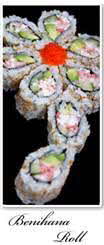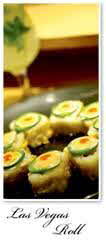GUIDE TO ORDERING SUSHIBenihana’s Ordering Sushi 101Celebrate International Sushi Day (June 18) with Benihana’s guide to ordering sushi below. Then, stop in to your local Benihana to try one of our delicious specialty rolls! * Sushi uses Japanese sticky rice seasoned with a sweet rice vinegar (a mixture of sugar and rice vinegar) as it is cooled and then adorned with raw fish, vegetables, Japanese omelet, or even barbequed eel (anago or unagi). The most popular types of sushi include:
- Maki: Sliced rolls
- Futomaki: thick (2-2½ inch wide) sliced rolls with many ingredients inside
- Hosomaki: thin (1 inch wide) sliced rolls with seaweed on the outside
- Uramaki: Inside-out rolls (rice on the outside, seaweed on the inside)
- Nigiri: Finger sushi, pieces of fish on top of rice
- Sashimi: Beautifully arranged slice fish only (no rice or vegetables)
- Temaki: Cone-shaped hand rolls, meant to be eaten like an ice cream cone

* Wasabi commonly accompanies sushi rolls. It is a Japanese horseradish made from an olive-green root with bumpy skin. True wasabi is ground on a shark’s skin board. Ordinary graters will cause the wasabi to lose its heat and take on a chunkier, rather than smooth consistency. Since wasabi can have a strong sensation, only try a small amount at a time, until you know the amount your body can handle.
* Sushi is meant to be eaten in one bite and designed to be picked up by chopsticks. It is important to only dip the fish side of the sushi into the sauce since dipping the rice side of the sushi into the sauce usually makes it fall apart.
* Saké is a Japanese alcoholic beverage made from fermented rice, containing about 16 percent alcohol. Like wine, saké has many different varieties and is evaluated by its quality and grade. There are more than 10,000 different brands of saké that can be distinguished by subtle differences in ingredients and the specific brewing process. There is one type of saké, called amazake, or “sweet saké,” which is non-alcoholic. | 